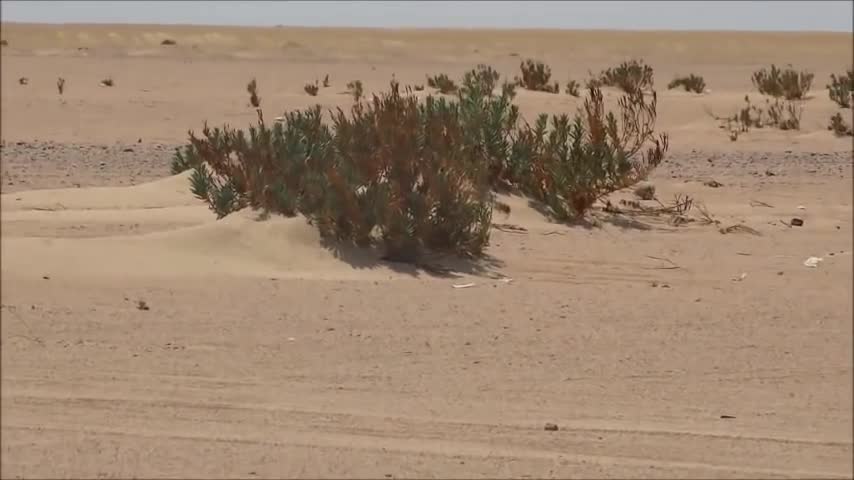Premium Only Content

Birds Hunting in Arab Desert
Doves are strong, fast fliers and noisy too, as they clap their wings together when they start into flight. Doves can live in deserts because they can fly long distances to find food and water. During winter they congregate, but pair off during breeding season. Dove nests look like flimsy, careless arrangements, and they can be built almost anywhere in trees, on the ground, in hanging pots. A pair can raise several broods a year.
The Inca Dove has the longest breeding season of any Arizona bird: January to November. That fact, plus its preference for grass and weed seeds, have made the Inca Dove the most abundant bird in southwestern urban areas, after the house sparrow.
White-winged Doves are important players in the life history of the saguaro. Along with bats, bees, and other insects, they help pollinate it as they fly from flower to flower to sip nectar. White-winged Doves also disperse saguaro seeds: they eat the fruit, then regurgitate it to their young; in the process some seed falls beneath the nest where it germinates, and the young saguaro grows in the protection of the tree.
The Sonoran Desert would have a very different sound if it were not for the doves. The cooing songs of four species are among the classic bird voices here for much of the year.
The desert they are among the most numerous birds year-round. A bigger relative, the White-winged Dove, is extremely common along southwestern rivers in summer. The rich cooing of the white-wings on spring mornings may virtually drown out the voices of other birds. More unobtrusive is the little Common Ground-Dove, which usually stays close to dense thickets. Another small species, the Inca Dove, is not really a desert bird; it is more likely to be found mincing about on lawns.
About 300 species of doves and pigeons are found worldwide. All have short blunt bills, stout bodies, and rather small heads. Our doves eat mostly seeds, but tropical species may eat many small fruits as well. Dove nests are haphazard platforms of sticks, so flimsy that the eggs or young sometimes fall through them; as if to make up for this, the birds may make repeated nesting attempts, raising several broods per year.
Doves love water, and it is only through their strong powers of flight that they are able to thrive in the desert; they may fly long distances to get to reliable sources of water. Flocks of doves hurtling overhead are a characteristic sight on desert evenings.
The Mourning Dove is found in all desert habitats throughout the year. The Inca Dove is most often found around human settlements throughout much of the Sonoran Desert region. The Common Ground-Dove is found throughout the year most often in dense brushy desert or in riparian areas
Diet: All 4 doves are seed and fruit eaters. Doves grind seeds in their muscular stomachs (or gizzards) using sand or gravel much like internal teeth.
-
 0:52
0:52
SEE NATURE
2 years agoPelicans eating fish | Birds | Pelican Hunting
11 -
 15:40
15:40
Live the Dream with Tony and Lori
2 years agoDesert Sheep Hunting Sonora Mexico 2022
28 -
 22:48
22:48
flushemndustem
2 years ago $0.01 earnedPheasant Hunting in the RAIN! Solid Number of Birds!
31 -
 6:57
6:57
DepressedGinger
21 hours ago $0.98 earnedThe craziest 9/11 story you've never heard of...
10.9K13 -
 17:10
17:10
Tundra Tactical
16 hours ago $6.39 earnedEXCLUSIVE Zev Heartbreaker Pistol Hands-On Review!
80.6K4 -
 30:39
30:39
MYLUNCHBREAK CHANNEL PAGE
20 hours agoThe Biggest Heist in Human History
85.2K73 -
 11:34:07
11:34:07
Tommy's Podcast
13 hours agoE725: Nosler, Oregon
74.3K4 -
 15:32
15:32
T-SPLY
1 day agoDems Turn on Fetterman in Brutal Betrayal!
161K187 -
 1:00
1:00
Damon Imani
18 hours agoHe ENDED Biden's Gaslighting About His Cognitive Decline!
3.72K6 -
 46:21
46:21
SGT Report
18 hours agoAMERICA THE BEAUTIFUL & OTHER REAL NEWS -- Sam Anthony
27.3K42